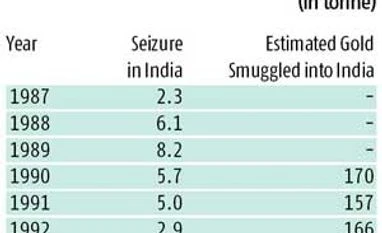Twenty metric tonnes (MT) of gold from the government account was made available to the SBI for sale with a repurchase option to yield a little more than US$ 200.0 million. The financial terms and conditions and the procedure for sale and repurchase were finalised, based on the advice of the Reserve Bank on financial prudence and the need for secrecy and urgency. Accordingly, the UBS bought the gold from the SBI at the London fixing price prevailing on the day after the day of delivery for each consignment. The SBI was paid 95.0 per cent of the value of the gold as loan; the remaining 5.0 per cent of the payment was to be settled at the end of six months. The exact quantity of gold transacted by the SBI was 19.65 MT of assorted purity, corresponding to 18.36 MT of gold of 100.0 per cent purity. The consideration paid by the UBS to the SBI was US$ 200.0 million. The effective rate of interest was 6.33 per cent, corresponding to the LIBOR. The gold, in effect, was acting as collateral for the loan given by the UBS to the SBI. It was further agreed that if the price of gold changed beyond the original price by more than 5.0 per cent, a fresh transaction would take place. If the price went up by more than 5.0 per cent, the UBS was to make available an additional loan to the SBI so that the total loan was 95.0 per cent of the new value. The gold was repurchased by the SBI in November/December 1991 and the gold of 18.36 tonnes was subsequently sold by the Government to the Reserve Bank. The remaining 1.63 tonnes of gold was returned by the SBI to the Government. Both these transactions added to the Reserve Bank's gold holding to the extent of 65.27 tonnes, which was kept abroad at that time.
Earlier, the SBI used to import gold to meet the needs of jewellery exporters under the gold jewellery export promotion and replenishment scheme. In order to conserve foreign exchange, the Government decided to stop importing gold with effect from October 1,1990, and asked the SBI to use confiscated gold lying in the government mint for use by jewellery exporters.
The gold holdings of the Reserve Bank at US$ 3,499.0 million at end-March 1992 reflected an addition to gold stocks to the extent of 18.36 tonnes and reached a level of 350.92 tonnes. This addition resulted from the sale of gold by the Government to the Reserve Bank, equivalent to the value of US$ 191.0 million. As part of the reserves management policy and as a means of raising resources, the Reserve Bank in July 1991 pledged 46.91 tonnes of gold with the Bank of Japan (BoJ) and the Bank of England (BoE) and raised a loan of US$ 405.0 million. This loan was redeemed by the Reserve Bank by repayment between September and November 1991.
The Reserve Bank decided to approach the BoJ and the BoE for foreign currency loans against the pledge of gold, presumably because banks in Tokyo and London had not stopped accepting commercial bills. Also, the two central banks and commercial banks in these countries were favourably inclined to extend assistance to India. The Reserve Bank Governor paid a visit to the BoJ to hold discussions with his counterpart and deputed the chief of the Department of External Investments and Operation (DEIO), Reserve Bank to the BoE. Both the foreign central banking authorities were willing to extend loans only against securities like gold and that too against physical transfer of gold. They would not agree to the proposal that since the Reserve Bank was an IMF depository, it could keep the gold with itself. Accordingly, the Reserve Bank, under the personal supervision of the DEIO chief, arranged with utmost urgency and secrecy to airlift the gold to the BoE.
In this connection, the Finance Minister made a statement in Parliament on July 18, 1991, articulating the entire issue of gold transactions by the SBI and the Reserve Bank and other measures envisaged to face the BoP challenge.
The import of gold was considered to be non-productive and it was not considered prudent to use scarce foreign exchange resources for this purpose. Therefore, import of gold was highly restricted and was permitted only against a licence. The import of jewellery in passenger baggage was also restricted through the high rate of baggage duty and quantitative and value restrictions. There was, however, continuous and substantial import of gold over the years using illegal channels as indicated by the figures of seizures.
This led the Government to re-examine the issue of gold imports. In the budget of 1992-93, the Government partially liberalised the import of gold by introducing a window for passengers to import gold by paying duty in foreign exchange. Subsequent to the import trade control (ITC) order, which was issued by the Directorate General of Foreign Trade (DGFT), Ministry of Commerce, the rate of duty was reduced from Rs 450 per 10 gms. to Rs 220 per 10 gms and passengers were given the option not to carry the gold themselves, but to purchase gold from SBI's bonded warehouse.
A similar scheme for the import of silver in baggage was announced with effect from February 9, 1993. Under this scheme, eligible passengers were allowed to import silver by paying duty in foreign exchange at the rate of Rs 500 per kg up to a limit of 100 kg.
Reproduced with permission from Reserve Bank of India history series. Volume 4, 1981-1997, Part A
)